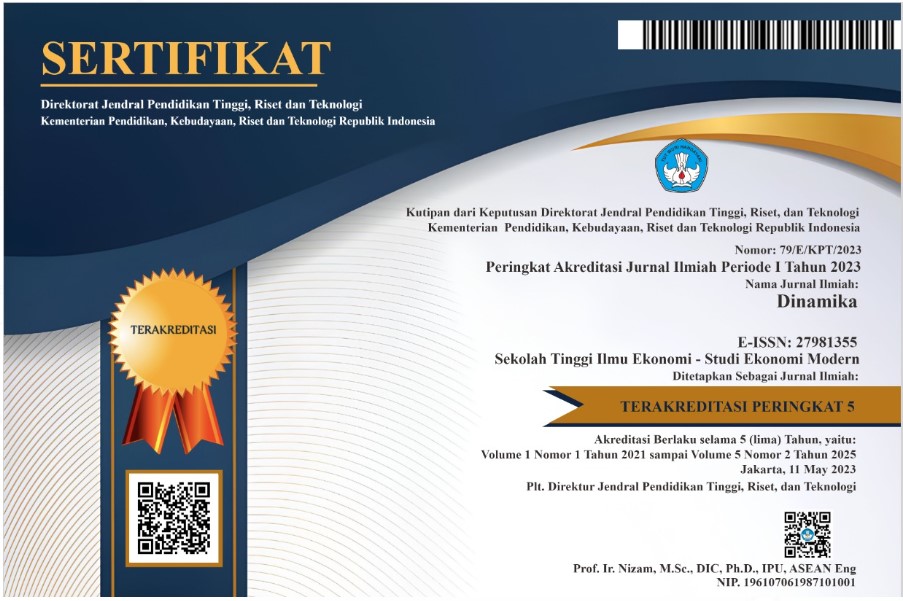Meningkatnya Marketing Performance Perusahaan Konstruksi Sebagai Dampak Hubungan Yang Signifikan Antara Digital Marketing Capabilities Terhadap Service Quality
DOI:
https://doi.org/10.51903/dinamika.v3i1.368Keywords:
Digital Marketing Capabilities, Service Quality, Marketing PerformanceAbstract
The purpose of this research is to examine the role of service quality in creating a significant relationship between digital marketing capabilities and marketing performance in construction companies on the island of Java. The research method was carried out quantitatively by collecting data by distributing questionnaires through electronic forms and printed formats which were delivered directly to respondents where the respondents were directors working at contractor companies on the island of Java. The sampling technique was carried out purposively based on the distinction of directors who had worked for at least five years in positive companies on the island of Java. Based on these criteria, there are 211 company directories that have met these criteria. Data were analyzed using statistical software AMOS 22. The results showed that digital marketing capabilities had a positive and significant effect on service quality. Digital marketing capabilities have a positive and significant effect on marketing performance. Likewise, service quality has a positive and significant effect on marketing performanceReferences
Ai Ping, T., Kaih Yeang, L., & Rajendran, M. (2017). The Impact of Enterprise Risk Management, Strategic Agility, and Quality of Internal Audit Function on Firm Performance. International Review of Management and Marketing, 7(1), 222–229. Retrieved from http://erm.ncsu.edu/az/erm/i/chan/library/ERMJFAPaper21306.pdf
Al-Hawary, S. I., & Al-Syasneh, M. S. (2020). Impact of dynamic strategic capabilities on strategic entrepreneurship in presence of outsourcing of five stars hotels in Jordan. Business: Theory and Practice, 21(2), 578–587. https://doi.org/10.3846/btp.2020.11895
Al-Nady, B. A. H. A., Al-Hawary, S. I. S., & Alolayyan, M. N. (2016). The role of time, communication, and cost management on project management success: An empirical study on sample of construction projects customers in Makkah City, Kingdom of Saudi Arabia. International Journal of Services and Operations Management, 23(1), 76–112. https://doi.org/10.1504/IJSOM.2016.073293
Altarifi, S., Ibraheem, S., Al-Hawary, S., Emad, M., & Al Sakkal, E. (2015). Determinants of E-Shopping and its Effect on Consumer Purchasing Decision in Jordan. International Journal of Business and Social Science, 6(1). Retrieved from www.ijbssnet.com
Amelda, B., Alamsjah, F., & Elidjen. (2021). Does the Digital Marketing Capability of Indonesian Banks Align with Digital Leadership and Technology Capabilities on Company Performance? CommIT Journal, 15(1), 9–17. https://doi.org/10.21512/commit.v15i1.6663
Anderson, E. W., & Sullivan, M. W. (1993). The Antecedents and Consequences of Customer Satisfaction for Firms Author ( s ): Eugene W . Anderson and Mary W . Sullivan Published by : INFORMS Stable URL : http://www.jstor.org/stable/184036 Accessed : 02-05-2016 18 : 18 UTC Your use of the JSTOR arch. Marketing Science, 12(2), 125–143.
Anna Arbussa ,Andrea Bikfalvi, P. M. (2017). Strategic Agility driven business model renewal. The Eletronic Library (Vol. 34).
Apasrawirote, D., Yawised, K., & Muneesawang, P. (2022). Digital marketing capability: the mystery of business capabilities. Marketing Intelligence and Planning, 40(4), 477–496. https://doi.org/10.1108/MIP-11-2021-0399
Armstrong & Kotler. (2018). Principles of Marketing. New York: Pearson International., 735.
Ayimey, E. K., Blomme, R. J., Kil, A., & Honyenuga, B. Q. (2021). Insight into How Market Orientation Impacts Marketing Performance in the Hotel Industry of Ghana. Emerald Publishing Limited, 16, 115–140. https://doi.org/10.1108/s1745-354220200000016009
Bamert, T., & Wehrli, H. P. (2005). Service quality as an important dimension of brand equity in Swiss services industries. Managing Service Quality, 15(2), 132–141. https://doi.org/10.1108/09604520510585325
Battistella, C., De Toni, A. F., De Zan, G., & Pessot, E. (2017). Cultivating business model agility through focused capabilities: A multiple case study. Journal of Business Research, 73, 65–82. https://doi.org/10.1016/j.jbusres.2016.12.007
Bell, J., & Loane, S. (2010). “New-wave” global firms: Web 2.0 and SME internationalisation. Journal of Marketing Management, 26(3–4), 213–229. https://doi.org/10.1080/02672571003594648
Berg, T., Burg, V., Gombović, A., & Puri, M. (2020). On the Rise of FinTechs: Credit Scoring Using Digital Footprints. Review of Financial Studies, 33(7), 2845–2897. https://doi.org/10.1093/rfs/hhz099
Brady, M. K., & Cronin, J. J. (2001). Some new thoughts on conceptualizing perceived service quality: A hierarchical approach. Journal of Marketing, 65(3), 34–49. https://doi.org/10.1509/jmkg.65.3.34.18334
Buttle;Stan Maklan. (2021). Customer relationship management. Digital Marketing Fundamentals: From Strategy to ROI.
Capaldo, A., & Messeni Petruzzelli, A. (2011). In search of alliance-level relational capabilities: Balancing innovation value creation and appropriability in R&D alliances. Scandinavian Journal of Management, 27(3), 273–286. https://doi.org/10.1016/j.scaman.2010.12.008
Chen, M. C., Hsu, C. L., & Lee, L. H. (2019). Service quality and customer satisfaction in pharmaceutical logistics: An analysis based on Kano model and importance-satisfaction model. International Journal of Environmental Research and Public Health, 16(21). https://doi.org/10.3390/ijerph16214091
Chen, Y., Wang, Y., Nevo, S., Jin, J., Wang, L., & Chow, W. S. (2014). IT capability and organizational performance: The roles of business process agility and environmental factors. European Journal of Information Systems, 23(3), 326–342. https://doi.org/10.1057/ejis.2013.4
Chinakidzwa, M., & Phiri, M. (2020). Impact of digital marketing capabilities on market performance of small to medium enterprise agro-processors in Harare, Zimbabwe. Business: Theory and Practice, 21(2), 746–757. https://doi.org/10.3846/btp.2020.12149
Clark, B. H., Abela, A. V., & Ambler, T. (2006). An information processing model of marketing performance measurement. Journal of Marketing Theory and Practice, 14(3), 191–208. https://doi.org/10.2753/MTP1069-6679140302
Daniel Kindström, C. K. (2014). Service innovation in business- ‐ to business firms. Journal of Business & Industrial Marketing, 29(2).
Denning, S. (2017). The next frontier for Agile: strategic management. Strategy and Leadership, 45(2), 12– 18. https://doi.org/10.1108/SL-02-2017-0021
Denning, S. (2018). How major corporations are making sense of Agile. Strategy and Leadership, 46(1), 3– 9. https://doi.org/10.1108/SL-11-2017-0104
Fan, W. S., & Tsai, M. C. (2010). Factors driving website success - the key role of internet customisation and the influence of website design quality and internet marketing strategy. Total Quality Management and Business Excellence, 21(11), 1141–1159. https://doi.org/10.1080/14783363.2010.529335
Fute, W., & Lyimo, B. J. (2019). Influence of digital marketing on performance of banking industry: a case of Barclays bank, Tanzania. Olva Academy–School of Researchers, Vol. 2, Issue 3. Olva Academy– School of Researchers, 2(3). Retrieved from https://www.academia.edu/download/61189382/W1F20191111-111942-1hqgsil.pdf
Gao, Y. (2010). Measuring marketing performance: a review and a framework. The Marketing Review, 10(1), 25–40. https://doi.org/10.1362/146934710x488924
Gronroos, C. (1984). A Service Quality Model and its Marketing Implications. European Journal of Marketing, 18(4), 36–44. https://doi.org/10.1108/EUM0000000004784
Hanafizadeh, P., Behboudi, M., Ahadi, F., & Varkani, F. G. (2012). Internet advertising adoption: A structural equation model for Iranian SMEs. Internet Research, 22(4), 499–526. https://doi.org/10.1108/10662241211251015
Herhausen, D., Miočević, D., Morgan, R. E., & Kleijnen, M. H. P. (2020). The digital marketing capabilities gap. Industrial Marketing Management, 90(March), 276–290. https://doi.org/10.1016/j.indmarman.2020.07.022
Homburg, C., & Wielgos, D. M. (2022). The value relevance of digital marketing capabilities to firm performance. Journal of the Academy of Marketing Science, 50(4), 666–688. https://doi.org/10.1007/s11747-022-00858-7
Hunt, S. D., & Madhavaram, S. (2020). Adaptive marketing capabilities, dynamic capabilities, and renewal competences: The “outside vs. inside” and “static vs. dynamic” controversies in strategy. Industrial Marketing Management, 89(July), 129–139. https://doi.org/10.1016/j.indmarman.2019.07.004
Indriastuti, H. (2019). Entrepreneurial innovativeness, relational capabilities, and value co-creation to enhance marketing performance. Humanities and Social Sciences Reviews, 7(3), 181–188. https://doi.org/10.18510/hssr.2019.7328
Ioannis, R., Angelos, N., & Nikolaos, T. (2023). Digital Marketing : The Case of Digital Marketing Strategies on Luxurious Hotels. Procedia Computer Science, 219(2022), 688–696. https://doi.org/10.1016/j.procs.2023.01.340
Izogo, E. E., & Ogba, I. E. (2015). Service quality, customer satisfaction and loyalty in automobile repair services sector. International Journal of Quality and Reliability Management, 32(3), 250–269. https://doi.org/10.1108/IJQRM-05-2013-0075
Jianjun, H., Yao, Y., Hameed, J., Kamran, H. W., Nawaz, M. A., Aqdas, R., & Patwary, A. K. (2021). The Role of Artificial and Nonartificial Intelligence in the New Product Success with Moderating Role of New Product Innovation: A Case of Manufacturing Companies in China. Complexity, 2021. https://doi.org/10.1155/2021/8891298
Kale, E., Aknar, A., & Başar, Ö. (2019). Absorptive capacity and firm performance: The mediating role of strategic agility. International Journal of Hospitality Management, 78(January 2018), 276–283. https://doi.org/10.1016/j.ijhm.2018.09.010
Kaleka, A., & Morgan, N. A. (2019). How marketing capabilities and current performance drive strategic intentions in international markets. Industrial Marketing Management, 78, 108–121. https://doi.org/10.1016/j.indmarman.2017.02.001
Kamp, J.-W. (2016). The effect of relational capabilities in the process of value co-creation within the context of SME’s. University of Twente Netherlands Netherlands.
Kandampully, J. (2010). Service quality to service loyalty : A relationship which goes beyond customer services Ser vice quality to service loyalty : A relationship which goes beyond custom er. Total Quality Management, (July 2012), 37–41.
Kannan, P. K., & Li, H. “Alice.” (2017a). Digital marketing: A framework, review and research agenda. International Journal of Research in Marketing, 34(1), 22–45. https://doi.org/10.1016/j.ijresmar.2016.11.006
Kannan, P. K., & Li, H. “Alice.” (2017b). Digital marketing: A framework, review and research agenda. International Journal of Research in Marketing, 34(1), 22–45. https://doi.org/10.1016/j.ijresmar.2016.11.006
Kerdpitak, C. (2022). The effects of innovative management, digital marketing, service quality and supply chain management on performance in cultural tourism business. Uncertain Supply Chain Management, 10(3), 771–778. https://doi.org/10.5267/j.uscm.2022.4.005
Kohtamäki, M., & Rajala, R. (2016). Theory and practice of value co-creation in B2B systems. Industrial Marketing Management, 56, 4–13. https://doi.org/10.1016/j.indmarman.2016.05.027
Korkpoe, C. H., & Nyarku, K. M. (2013). Building an Organizational Culture that Promotes Innovation in IT Firms. International Journal of Strategic Information Technology and Applications, 4(1), 1–14. https://doi.org/10.4018/jsita.2013010101
Kurniawan, R., Budiastuti, D., Hamsal, M., & Kosasih, W. (2021). Nking capability and firm performanceetwor: the mediating role of market orientation and business process agility. Journal of Business and Industrial Marketing, 36(9), 1646–1664. https://doi.org/10.1108/JBIM-01-2020-0023
Kurniawan, R., Manurung, A. H., Hamsal, M., & Kosasih, W. (2021). Orchestrating internal and external resources to achieve agility and performance: the centrality of market orientation. Benchmarking, 28(2), 517–555. https://doi.org/10.1108/BIJ-05-2020-0229
Kusumajaya, R., & Rivai, A. (2019). Pengaruh Citra Lembaga Dan Kualitas Layanan Terhadap Kepuasan Dan Komitmen Relasional Dan Dampaknya Pada Positive Word Of Mouth. Jurnal Ilmiah Telaah Manajemen, 14(2)
Lee, Y. K., Kim, S. H., Seo, M. K., & Hight, S. K. (2015). Market orientation and business performance: Evidence from franchising industry. International Journal of Hospitality Management, 44, 28–37. https://doi.org/10.1016/j.ijhm.2014.09.008
Liu, H. M., & Yang, H. F. (2019). Network resource meets organizational agility: Creating an idiosyncratic competitive advantage for SMEs. Management Decision, 58(1), 58–75. https://doi.org/10.1108/MD-10-2017-1061
M, Jenyo Gabriel K, S. K. (2015). Online Marketing And Consumer Purchase Behaviour: A Study Of Nigerian Firms. British Journal of Marketing Studies, 3(7), 1–23.
Matarazzo, M., Penco, L., Profumo, G., & Quaglia, R. (2021). Digital transformation and customer value creation in Made in Italy SMEs: A dynamic capabilities perspective. Journal of Business Research, 123(February 2020), 642–656. https://doi.org/10.1016/j.jbusres.2020.10.033
Mihardjo, L. W. W., Sasmoko, Elidjen, & Rukmana, R. A. N. (2019). Developing co-creation-driven innovation: The role of customer experience orientation and organizational agility. International Journal of Recent Technology and Engineering, 8(2 Special Issue 9), 719–726. https://doi.org/10.35940/ijrte.B1152.0982S919
Mishra, P., Pandey, C. M., Singh, U., Gupta, A., Sahu, C., & Keshri, A. (2019). Descriptive statistics and normality tests for statistical data. Annals of Cardiac Anaesthesia, 22(1), 67–72. https://doi.org/10.4103/aca.ACA_157_18
Muninger, M. I., Hammedi, W., & Mahr, D. (2019). The value of social media for innovation: A capability perspective. Journal of Business Research, 95(October 2018), 116–127. https://doi.org/10.1016/j.jbusres.2018.10.012
Nupur Krishna, M. D. I. (MDI), & Jagriti Singh, A. U. (2018). Factors Affecting B2B E-Commerce Adoption Decision: an Analysis of Indian Textile Industry. Academy of Marketing Studies Journal, 22(2), 1– 10.
Nuseir, M., & Refae, G. El. (2022). The effect of digital marketing capabilities on business performance enhancement: Mediating the role of customer relationship management (CRM). International Journal of Data and Network Science, 6(2), 295–304. https://doi.org/10.5267/j.ijdns.2022.1.008
Nwokah, N. G. (2009). Customer-focus, competitor-focus and marketing performance. Measuring Business Excellence, 13(3), 20–28. https://doi.org/10.1108/13683040910984293
Okdinawati, L., Simatupang, T. M., & Sunitiyoso, Y. (2015). Value Co-creation Map in Collaborative Transportation. Procedia Manufacturing, 4(Iess), 71–78. https://doi.org/10.1016/j.promfg.2015.11.016
Olazo Danzen. (2022). Measuring the level of Digital Marketing Capabilities, Digital Marketing Strategies and Challenges and Issues of SMEs in adopting Digital Marketing. Journal of Marketing Advances and Practices, 4(1), e-ISSN 2682-8170.
P. Foroudi, S. Gupta, A. Nazarian, and M. D. (2017). Digital technology and marketing management capability: Achieving growth in SMEs. Qualitative Market Research: An International Journal, 22(2), 112–122.
Pandey, N. (2015). Havells India Limited: Transition from an Industrial Brand to a Consumer Brand. The Journal for Decision Makers, 40(3), 383–387. https://doi.org/10.1177/0256090915600296
Pandey, N., Nayal, P., & Rathore, A. S. (2020). Digital marketing for B2B organizations: structured literature review and future research directions. Journal of Business and Industrial Marketing, 35(7), 1191– 1204. https://doi.org/10.1108/JBIM-06-2019-0283
Parasuraman, A., Zeithaml, V. A., & Berry, L. L. (1985). A Conceptual Model of Service Quality and Its Implications for Future Research. Journal of Marketing, 49(4), 41. https://doi.org/10.2307/1251430
Parasuraman, A., Zeithaml, V. A., & Malhotra, A. (2005). E-S-QUAL a multiple-item scale for assessing electronic service quality. Journal of Service Research, 7(3), 213–233. https://doi.org/10.1177/1094670504271156
Rahman, M., Rodríguez-Serrano, M. Á., & Lambkin, M. (2017). Corporate social responsibility and marketing performance: The moderating role of advertising intensity. Journal of Advertising Research, 57(4), 368–378. https://doi.org/10.2501/JAR-2017-047
Ranjan, K. R., & Read, S. (2016). Value co-creation: concept and measurement. Journal of the Academy of Marketing Science, 44(3), 290–315. https://doi.org/10.1007/s11747-014-0397-2
Rezazadeh, A., & Nobari, N. (2018). Antecedents and consequences of cooperative entrepreneurship: a conceptual model and empirical investigation. International Entrepreneurship and Management Journal, 14(2), 479–507. https://doi.org/10.1007/s11365-017-0470-7
Rust, R., & Oliver, R. (2012). Service Quality: New Directions in Theory and Practice. Service Quality: New Directions in Theory and Practice, 1–21. https://doi.org/10.4135/9781452229102
Rymaszewska, A., Helo, P., & Gunasekaran, A. (2017). IoT powered servitization of manufacturing – an exploratory case study. International Journal of Production Economics, 192, 92–105. https://doi.org/10.1016/j.ijpe.2017.02.016
Şahin, A., Zehir, C., & Kitapçı, H. (2012). The effects of brand experience and service quality on repurchase intention: The role of brand relationship quality. African Journal of Business Management, 6(45), 11190–11201. https://doi.org/10.5897/AJBM11.2164
Salamah, A. A., Hassan, S., Aljaafreh, A., Zabadi, W. A., AlQudah, M. A., Hayat, N., … Kanesan, T. (2022). Customer retention through service quality and satisfaction: using hybrid SEM-neural network analysis approach. Heliyon, 8(9), e10570. https://doi.org/10.1016/j.heliyon.2022.e10570
Sambamurthy, V., Bharadwaj, A., & Grover, V. (2003). Shaping agility through digital options: Reconceptualizing the role of Information technology in Contemporary firms. Management Information Systems Research Center, 91(5), 1689–1699.
Sanchez, L. M., & Nagi, R. (2001). A review of agile manufacturing systems. International Journal of Production Research, 39(16), 3561–3600. https://doi.org/10.1080/00207540110068790
Santouridis, I., & Trivellas, P. (2010). Investigating the impact of service quality and customer satisfaction on customer loyalty in mobile telephony in Greece. TQM Journal, 22(3), 330–343. https://doi.org/10.1108/17542731011035550
Schneckenberg, D., Benitez, J., Klos, C., Velamuri, V. K., & Spieth, P. (2021). Value creation and appropriation of software vendors: A digital innovation model for cloud computing. Information and Management, 58(4), 103463. https://doi.org/10.1016/j.im.2021.103463
Simon;, A. C. B. S. and B. S. E. K. S., & Department. (2015). Business leaders’ views on the importance of strategic and dynamic capabilities for successful financial and non-financial business performance. International Journal of Productivity and Performance Management, 53(2), 177–196. Retrieved from https://doi.org/10.1108/JEA-06-2013-0067
Sridhar, S., & Fang, E. (2019). New vistas for marketing strategy: digital, data-rich, and developing market (D3) environments. Journal of the Academy of Marketing Science, 47(6), 977–985. https://doi.org/10.1007/s11747-019-00698-y
Tallon, P. P., Hall, F., Ave, C., College, B., Hill, C., & Tallon, P. P. (2008). Inside the Adaptive Enterprise: An Information Technology Capabilities Perspective on Business Process Agility. Research on Information Technology and Organizations, (March).
Tariq, E., Alshurideh, M., Akour, I., & Al-Hawary, S. (2022). The effect of digital marketing capabilities on organizational ambidexterity of the information technology sector. International Journal of Data and Network Science, 6(2), 401–408. https://doi.org/10.5267/j.ijdns.2021.12.014
Tarsakoo, P., & Charoensukmongkol, P. (2020). Dimensions of social media marketing capabilities and their contribution to business performance of firms in Thailand. Journal of Asia Business Studies, 14(4), 441–461. https://doi.org/10.1108/JABS-07-2018-0204
Teece, D., Peteraf, M., & Leih, S. (2016). Dynamic Capabilities and Organizational Agility. California Management Review, 58(4), 13–35.
Trainor, K. J., Andzulis, J., Rapp, A., & Agnihotri, R. (2014). Social media technology usage and customer relationship performance: A capabilities-based examination of social CRM. Journal of Business Research, 67(6), 1201–1208. https://doi.org/10.1016/j.jbusres.2013.05.002
Tzetzis, G., Alexandris, K., & Kapsampeli, S. (2014). Predicting visitors’ satisfaction and behavioral intentions from service quality in the context of a small-scale outdoor sport event. International Journal of Event and Festival Management, 5(1), 4–21. https://doi.org/10.1108/IJEFM-04-2013- 0006
Van Oosterhout, M., Waarts, E., & Van Hillegersberg, J. (2006). Change factors requiring agility and implications for IT. European Journal of Information Systems, 15(2), 132–145. https://doi.org/10.1057/palgrave.ejis.3000601
Wang, F. (2020). Digital marketing capabilities in international firms: a relational perspective. International Marketing Review, 37(3), 559–577. https://doi.org/10.1108/IMR-04-2018-0128
Waty, E., So, I. G., Indrajit, R. E., & Abdinagoro, S. B. (2022). Networking Capabilities and Digital Adoption of Business Agility: the Mediating Role of Business Model Innovation. International Journal of EBusiness and EGovernment Studies, 14(2), 224–241. https://doi.org/10.34109/ijebeg.202214131
Yang, Z., Huang, Z., Wang, F., & Feng, C. (2018). The double-edged sword of networking: Complementary and substitutive effects of networking capability in China. Industrial Marketing Management, January). https://doi.org/10.1016/j.indmarman.2017.10.010
Yoo, D. K., & Park, J. A. (2007). Perceived service quality. The International Journal of Quality & Reliability Management, 24(9), 908–926. https://doi.org/http://dx.doi.org/10.1108/02656710710826180
Yusuf, Y. Y., Gunasekaran, A., Musa, A., Dauda, M., El-Berishy, N. M., & Cang, S. (2014). A relational study of supply chain agility, competitiveness and business performance in the oil and gas industry. International Journal of Production Economics, 147(PART B), 531–543. https://doi.org/10.1016/j.ijpe.2012.10.009
Zhao, H., & Wu, Q. H. (2014). Custom service support management information system. Applied Mechanics and Materials, 687–691, 4840–4843. https://doi.org/10.4028/www.scientific.net/AMM.687- 691.4840
Zhou, J., Mavondo, F. T., & Saunders, S. G. (2019). The relationship between marketing agility and financial performance under different levels of market turbulence. Industrial Marketing Management, 83(October 2017), 31–41. https://doi.org/10.1016/j.indmarman.2018.11.008












